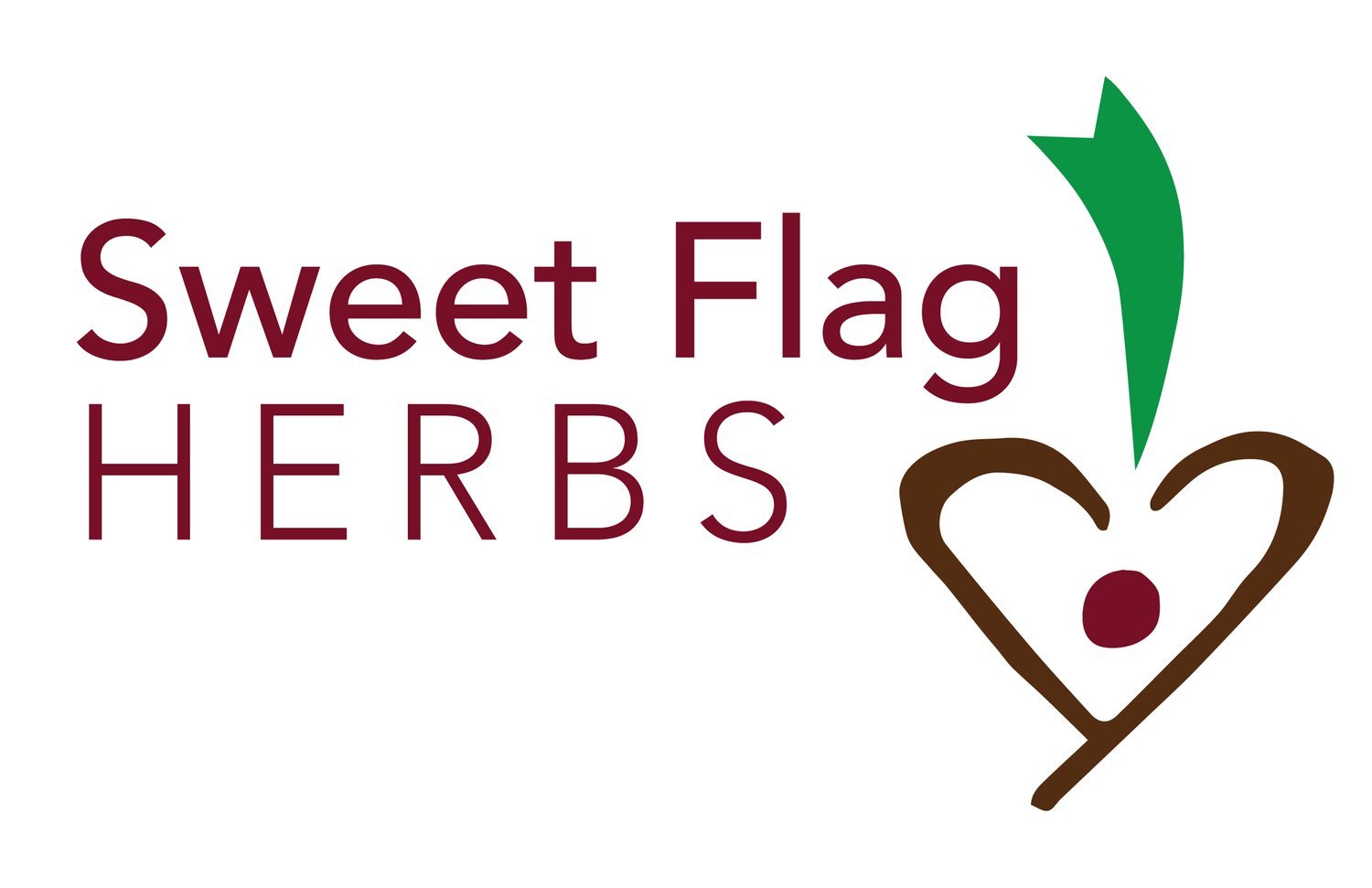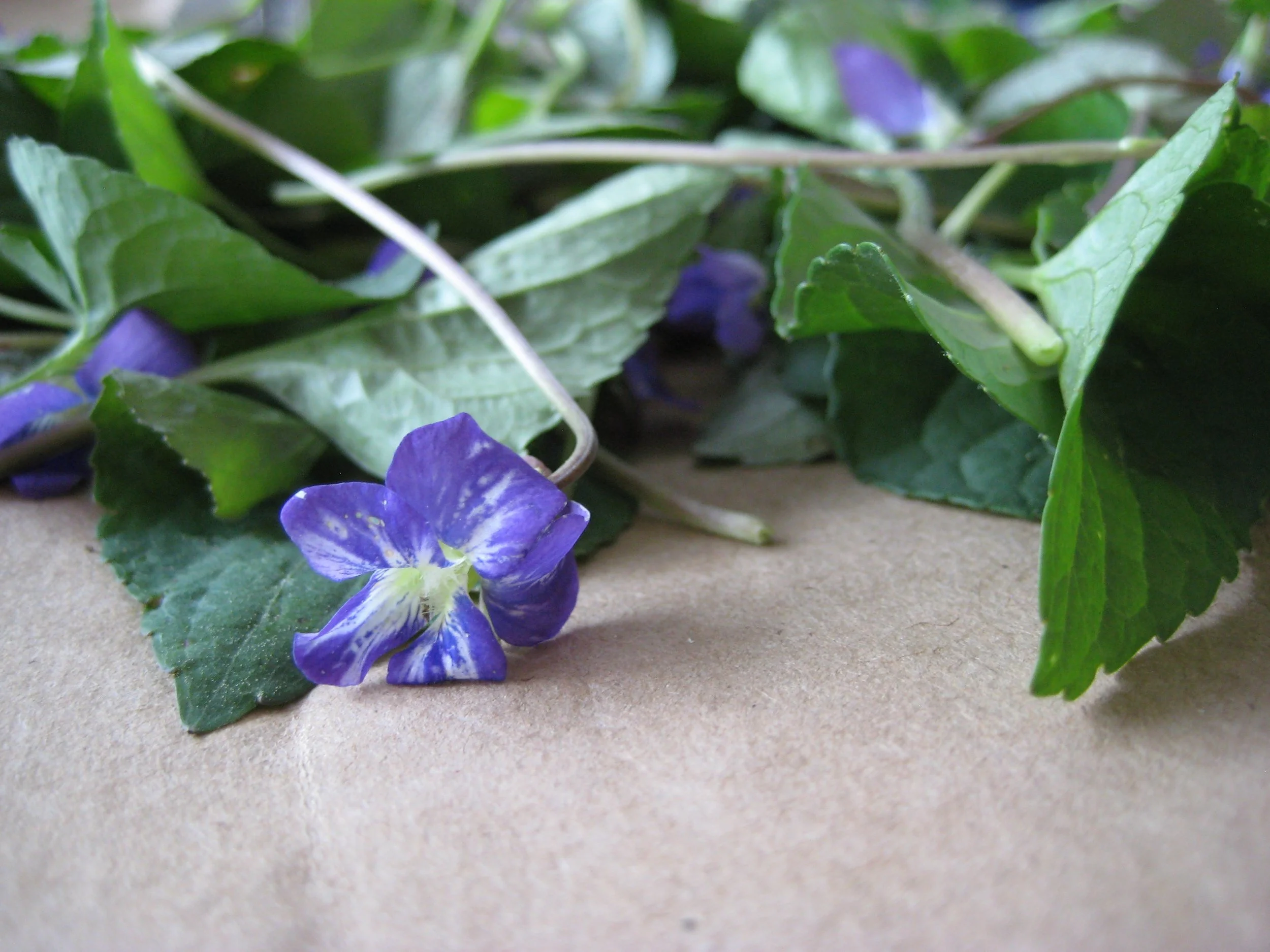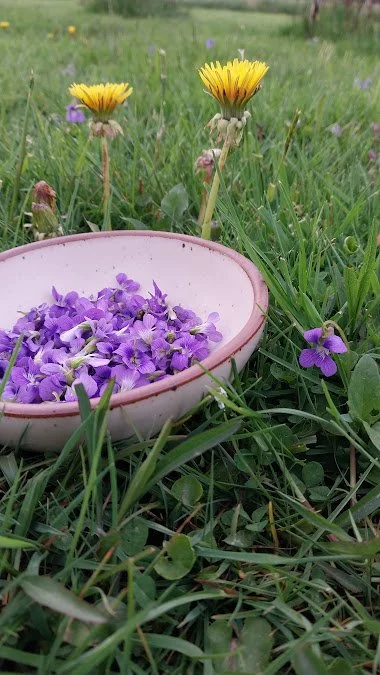Violets: St. Valentine’s Ink
I've been keeping an eye on the patches of violets poking up in our lawn, waiting for the right time to pick some leaves and flowers for salads. Though frequent bouts of cold this March have singed the leaves, new growth slowly emerges.
This plant knows how to hedge its bets. In addition to the deep purple flowers that will blossom soon, violets produce underground cleistogamous flowers in the summertime. These blooms are self-fertilizing, and never open (Erichson-Brown, 329).
Image: bowl full of freshly picked violet flowers. Pottery by East Fork Pottery.
Violets and St. Valentine
Though many think of roses for Valentine's Day, violets were a traditional flower of choice. This is partly due to St. Valentine lore.
Valentine was a popular name in Ancient Rome, and a number of people were known as St. Valentine (source). One was a priest persecuted by Claudius of Rome for his beliefs and work. While in prison, he wrote messages of encouragement to other believers.
The story goes that Valentine crushed violet flowers growing outside his cell window to make ink to write his letters. A cooperative dove is said to have delivered his loving messages (Beredjiklian).
One Valentine is said to have been executed on February 14th. His death coincided with pagan festivals of Lupercalia honoring Juno, the Roman goddess of love, marriage, and fertility. St. Valentine's holiday became associated with these values as well.
Violets played an integral part in Valentine's Day until quite recently. "It should...be noted that well into the 1930s, New Englanders still preferred their Valentine's box of candies topped with a bouquet of violets" (Beredjiklian). Violet's heart-shaped leaves are quite apropos!
Backyard Superfoods (aka Real Food)
Where I live in New York State, Viola sororia (common violet) is the species to harvest. It’s found in lawns and other disturbed spaces across Eastern North America.
Like so many wild edible plants, the nutrition content of violet leaves and flowers blows grocery store produce out of the water. In one study, springtime leaves of the common blue violet were found to contain five times as much vitamin C as oranges by weight, and 2.5 times more vitamin A than spinach (Zennie and Ogzewalla).
We humans spent much of our history eating wild greens; this level of nutrition was the norm. Over time, agricultural practices have reduced the amount of nutrition we obtain from fruits and vegetables. Conventional farmers and seed companies breed plants for easy shipping and packaging, "mild" agreeable flavor (read: watered down), and other economic interests-- not dense nutritional value. Produce is harvested prematurely and shipped thousands of miles, drastically losing vitamin content on the ride. Overworked, conventionally fertilized soil is degraded in nutritional content and healthy bacteria and fungi, affecting availability and absorption of crops' nutrients.
It has dawned on me that what we call superfoods are just foods with a more historically "normal" nutritional content. Kale is a "superfood" because brassicas haven't been bred too far from their wild counterparts.
Of course, we should feel good about eating fresh produce from whatever sources are available—particularly if it's home- or locally/sustainably grown. But when we add violets and other edible wild greens to our dishes, we greatly enhance the nutritional value of that meal.
Be sure to harvest from untreated lawns.
Image: Freshly harvested violet leaves and flowers rest on a paper bag.
Violet as a Spring Tonic
Herbalists often talk about spring tonics-- highly nutritious, often "weedy" plants that give our metabolism and waste excretion a kick. Some stimulate liver function; others get our lymph moving. Violet leaf is known for "relieving congestion in the lymphatic and respiratory systems" (Easley). After a dry winter, violet's mucilaginous, pleasantly slimy quality can soften and move lymphatic fluid and dry mucus.
Dr. John Gerarde's 1597 writings are a testament to violet’s cooling, moistening properties:
"The floures are good for all inflammations, especially of the sides and lungs; they take away the hoarsenesse of the chest, the ruggednesse of the windpipe and jaws, the extream heate of the liver, kidneys and bladder; mitigate the fierie heat of burning agues [fever]... and take away thirst" (Erichson-Brown).
That slimy mucilage is soluble fiber, which is used to support cholesterol management and healthy gut flora populations (source).
I love adding violet leaf+flower to teas, since steam helps move respiratory congestion, too. To get the most out of violet's nutrition and mucilage, violet is best prepared with a long steep (45 minutes to 8 hours). The tea can be reheated after straining.
Violet for Skin Support
Image: violets and dandelions adorn a lawn in springtime. Freshly harvested flowers in a white bowl.
Violet leaves and flowers are a staple for herb-infused salves. Mucilaginous, nutritious herbs are softening and moistening for the skin, or emollient. Click here for a simple recipe for making herb-infused oils for topical use.
Safety
Since there are some violet lookalikes, I suggest harvesting violet when it's in flower. The purple blossoms have a distinctive tail coming off the back. Depending on where you live, the forest may contain violet species that are rare, and even questionably edible in quantity. Harvesting common blue violets in springtime lawns is a safe bet as far as edibility and sustainability (source).
According to Juliet Blankespoor of the Chestnut School of Herbal Medicine, "The exact dosage is not especially important since it can safely be consumed in large quantities. As a gentle food herb, violet is generally safe for elders, youngsters, and people who are taking pharmaceuticals" (source).
Sources not linked:
Beredjiklian, Norma. "St. Valentine's Violets." The Violet Gazette, Winter 2001, V2-1,P7
Easley, Thomas. "The Modern Herbal Dispensatory." 2016.
Erichson-Brown. Medicinal and Other Uses of North American Plants: A Historical Survey With Special Reference to Eastern Indian Tribes.1979.
Zennie, Thomas M. and Dwayne C. Ogzewalla, 1977. "Ascorbic acid and vitamin A content of edible wild plants of Ohio and Kentucky." Economic Botany, 31: 76-79.



